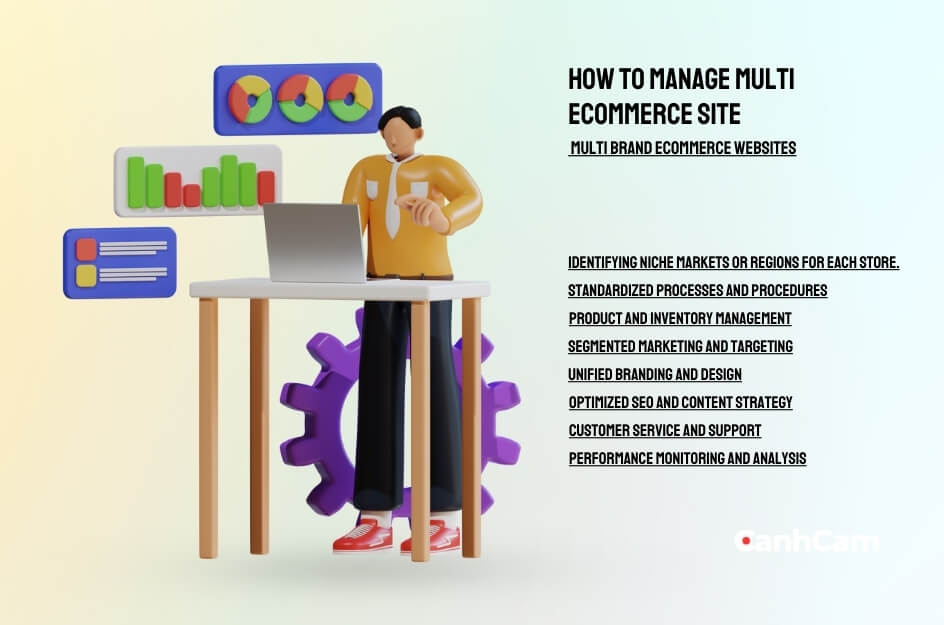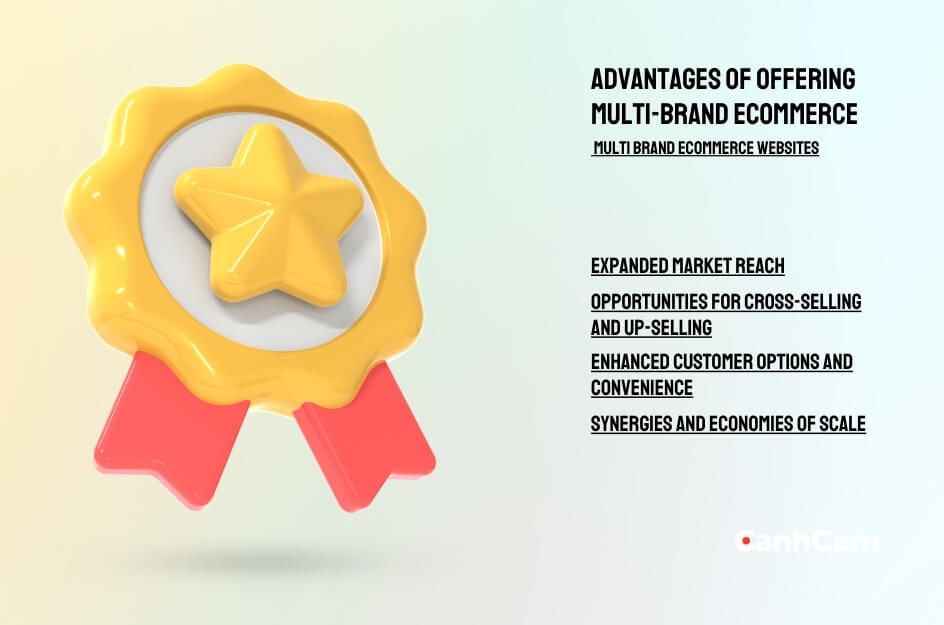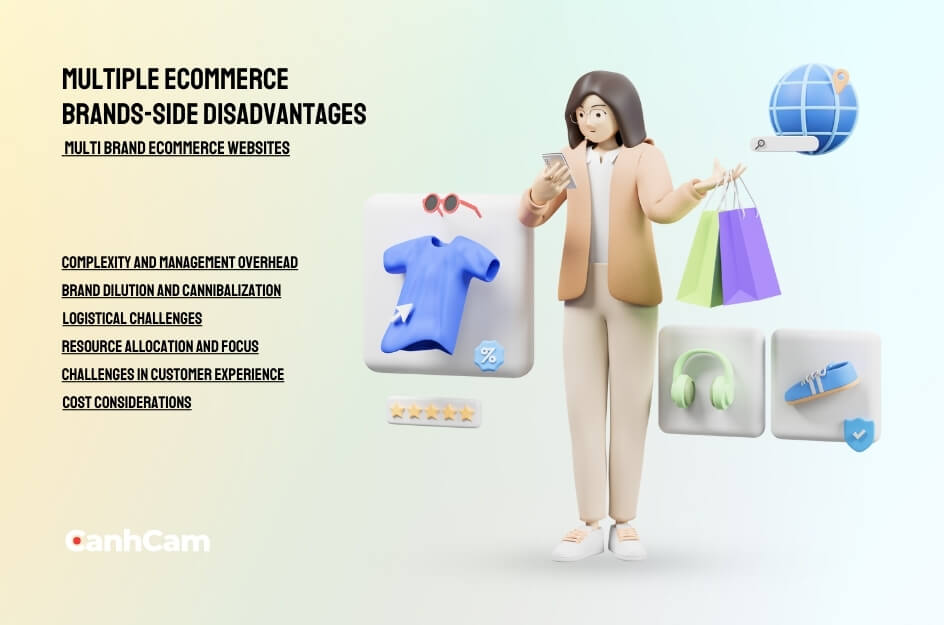In the expansive world of online shopping, multi-brand platforms shine as a promising opportunity. Did you know that the growth rate of multi brand ecommerce sites was retrospectively over 25% during the last year? This rapid rise in the value of cryptocurrency shows their role in the current market.
The multi brand ecommerce concept reflects the platforms that gather many brands in a single online space, allowing consumers to a variety of products. In addition to convenience, these platforms have many advantages such as serving the broader market, creating new revenue sources, and improving customer interaction.
In the same vein, the fact that it’s difficult to balance the brand identity and the operational complexity of multiple brands should not be ignored. This article by CanhCam will serve as a guideline for you to create the perfect multi brand ecommerce website that will contribute to the increase of your sales.
What Is a Multi-Brand Strategy?
A multi-brand ecommerce store is a typical retail store that offers products from various brands. This strategy might include the promotion of the products via numerous online channels, which would all be targeting the same market segment but through various company names and identities. The primary aim of using the multi-brand strategy is to increase the market share through marketing to different groups of customers or addressing different needs depending on the designated segment.
Read more: How to Growth a Marketing Strategies

This tactic allows companies to benefit from the economies of scale, take advantage of new market opportunities, and hedge risks that can arise when only dealing with one brand. Furthermore, it allows for market penetration into new regions, broadening of product categories, and deeper competitive advantage.
Is Multi-Brand Right for You?
Embarking on a multi-brand strategy necessitates thorough contemplation and deliberate reflection. Are you an entrepreneur aiming to expand your market reach, or perhaps a respected e-commerce store owner aiming to diversify your offerings?
Regardless of your business model, it's essential to evaluate whether adopting a multi brand approach is in line with your objectives. Here are some common scenarios encountered when discussing multi-location solutions with businesses:
- Merchants of course have the intention to do global sales through various sites.The goal for each business is its brand.
- The firms mainly develop their lines of new products or conquer new markets but at the same time, they maintain the ones already having.
- Companies want to use a single platform with decentralized setups while providing freedom and anonymity of several websites.
- Online shops that are scattered on different websites built on various platforms, each of them independent and autonomous, are eager to consolidate their platforms into a centralized platform.
- Companies, however, need to know which product categories they want to pick to serve their particular niche in the market.
- Retailing enterprises are excited to utilize B2B services.
- B2B enterprises are venturing to offer retail or direct-to-customer services.
- Franchise brands are likely to set up large numbers of websites for their members/users while having a centralized structure.
- Corporations might want a consolidated system to run their business conglomerates or multi-department enterprises.
How to Manage Multi Ecommerce Site?
Suppliers should view the development of each online store as if it were their sole operation. Simultaneously, suppliers should also see each online store as a tool in their overall business strategy. Some steps that suppliers can take to address both of these issues include:
Identifying niche markets or regions for each store.
Suppliers can establish stores that meet these niche market demands, which in turn may result in heightened loyalty and, thus, better customer retention. Integrated marketing may focus on differentiated markets, which may explain area, income, or sophisticated preferences, for instance.
Create Ecommerce website? Contact to us: Ecommerce Website Design Melbourne
Standardized processes and procedures
Establish standard procedures and processes to maintain uniformity as well as efficiency in the management of all e-commerce sites. Develop checklists, operating protocols, and standard operational procedures for tasks such as product upload, order processing, customer service, and marketing across all sites to maintain quality and uniformity.
Product and inventory management
Put in place vigorous inventory management systems for tracking stock, prices, and product information across all ecommerce channels. Use inventory management software for the real-time synchronization of inventory data to avoid overselling or stockouts. Centralized product catalog maintenance for updated and consistent product listings.

Segmented marketing and targeting
Develop customized segmented marketing strategies that are tailored to each site's audience and niche. Customize marketing campaigns, promotions, and content to cater to the audiences' demographics, preferences, and behaviors of each site. Leverage customer data and analytics to refine targeting and customize messaging for optimal results.
Unified branding and design
Ensure a consistent branding and design style across all ecommerce sites to enhance brand recognition and provide a consistent user experience. Leverage consistent brand elements such as logos, colors, fonts, and imagery to help display brand recognition and trust. Make sure that your site design and layout are aligned with your brand aesthetic and values.
Optimized SEO and content strategy
Design SEO and content strategies for each ecommerce site to increase visibility and attract organic traffic. Perform keyword research, include relevant keywords in on-page elements, and create content of high quality and relevance for each site's audience and products. Use LSI and Semantic keywords to boost search engine relevance and rankings.
Customer service and support
Ensure high-quality customer service throughout all ecommerce websites to improve customer experience. Provide various means of customer inquiries and support like live chat, email, and telephone help desk. Train customer service representatives to handle queries promptly and professionally, regardless of their origin site.
Performance monitoring and analysis
Conduct regular monitoring of ecommerce’s performance with analytics tools and KPIs. Monitor the main metrics, such as traffic, conversion rates, sales figures, and interaction, to identify and address improvement areas. Scrutinize the patterns of data and feedback to acquire essential information for targeted making of decisions and modification of your ecommerce strategy.
Advantages of Offering Multi-Brand Ecommerce
The advantages of selling various brands on your e-commerce store are not limited to just expanding the number of inventory and satisfying more customers. Following is the extra advantage of using more brands for your ecommerce store.
Expanded market reach
Omnichannel online platforms enable businesses to tap into a bigger audience, which is a great opportunity. Brands showcased on the platform also have their fan base. By introducing these brands in one digital space, businesses can bring a bigger crowd of potential customers who are interested not only in one product or brand but all of them. Such an increased market coverage boosts brand image and exposure, creating a high probability of attracting new customers and doing more business.
Opportunities for cross-selling and up-selling
Having multiple brands on an e-commerce website allows for cross-selling and up-selling. Through cross-selling, brands give recommendations for the second complementary products from other brands to customer based either on their purchase history or preferences.
Conversely, down-selling pitches customers to go for cheaper or low-end products within the same brand or across other brands. Brands and products alike can be better showcased to customers who in turn, will consider other options, boosting average orders and therefore, maximizing the revenue potential.

Enhanced customer options and convenience
On multi-brand e-commerce platforms, customers are provided with a broad selection of products and brands, which allows them to have more flexibility and convenience in the process of their shopping.
Instead of having to visit multiple websites or stores to get different brands' products, customers can find these products in one place and quickly compare them, thus simplifying the purchasing process.
This convenience element has the advantage of heightening the satisfaction level and customer loyalty by saving time and effort as well as providing customers with a vast range of choices that cater to different needs and preferences.
Synergies and economies of scale
Brand collaboration at a single ecommerce site can build synergies and economize on operations and marketing costs. Conjoint resources which are characterized by infrastructure, technology, and marketing channels can be pooled by multiple brands while the expense is reduced and efficiency is improved.
Strategic partnerships, collaborative marketing campaigns, and cross-promotional activities all play an important role in a great marketing plan by increasing brand recognition and outreach, which leads to more successful marketing.
Through resource sharing and expertise, companies will be able to find best practices and make their operations run ever more efficiently while ensuring that all brands in their portfolio are sustainable.
Multiple Ecommerce Brands-side Disadvantages
Although multi storefront ecommerce presents various advantages, it is crucial to assess potential drawbacks before committing to this approach.
Complexity and management overhead
Managing many stores at the same time can be multi-faceted and demanding. Every store needs perfect care about product listings, inventory management, pricing, and customer support.
Monitoring the performance metrics of multiple brands and making sure that consistency is maintained across all storefronts can present difficulties calling for management and staff to dedicate time and effort to the tasks.
Brand dilution and cannibalization
Hosting multiple brands on a single platform may result in brand dilution or cannibalization. If brands in the portfolio cater to similar customer segments or offer overlapping products, they might end up competing rather than complementing each other. This scenario can confuse customers and weaken brand identities, ultimately reducing the effectiveness of the multi storefront strategy.
Logistical challenges
Dealing with fulfillment and logistics becomes more complex when handling multiple storefronts. Coordinating inventory levels, shipping logistics, and order fulfillment across different brands and product lines demands careful planning and coordination. Ineffective logistics management can lead to delays, mistakes, and customer dissatisfaction, tarnishing the ecommerce platform's reputation.

Resource allocation and focus
Operating multiple storefronts can divert resources and focus from core business activities. Companies may struggle to balance the demands of various brands while overlooking strategic initiatives or innovation. This lack of focus can impede overall business performance and restrict growth opportunities, especially if resources are thinly spread across different brands.
Challenges in customer experience
Providing a consistent and coherent brand experience irrespective of channel becomes a daunting task for the company. Consumers expect to get a seamless experience across various brands or locations, as they interact with them. Any change in branding, product quality, or customer service can lead to confusion, and frustration, and even drive the customers away from the platform.
Cost considerations
Multiple location launches and operations give rise to additional expenditures due to website development, marketing, and operational costs. Companies have to analyze the ROI of each store in great detail to ensure these sales points are profitable.
Additionally, broader implementation of brands may require additional investments in infrastructure, technology and staff, which is only likely to increase the overall operations cost.
Through the conduct of a detailed analysis covering both the pros and the cons, businesses shall be able to point out if the multi-storefront e-commerce strategy matches their business objectives or not. It is significant to deal with these barriers effectively and to implement risk-mitigating tactics as well as to benefit from the multi-brand approach at the same time.
Wrap-up
Developing many websites that focus on one particular segment of your market is a superb opportunity to get new people to buy more which will help your company to extend its market as well as lead in the industry.
The implementation of the centralized management method, standardized processes, and technology resources contribute to operation rationalization, higher efficiency, and consistency over all the e-commerce websites.
Through goal-setting, tactful execution, and a customer-oriented approach, companies can manage several e-commerce sites and take advantage of the dynamic digital environment which provides a platform for business evolution and success.

